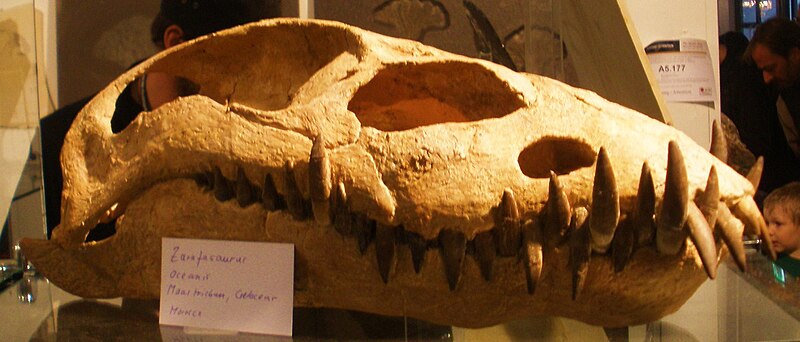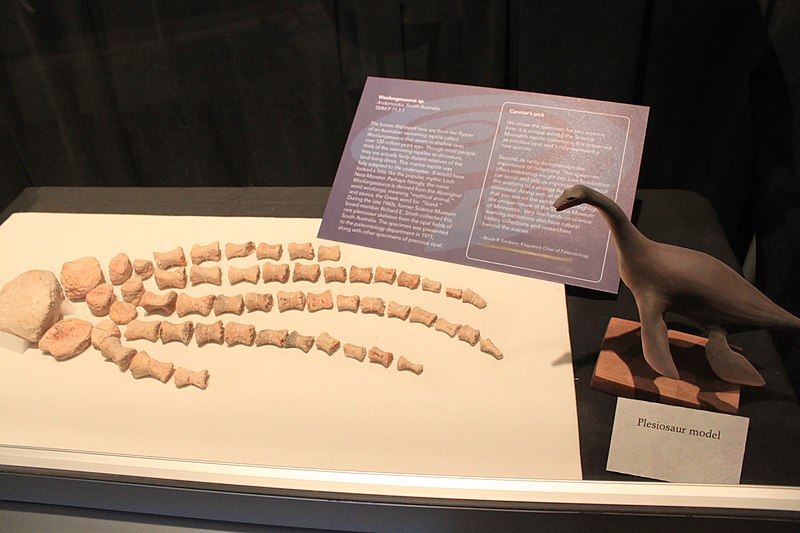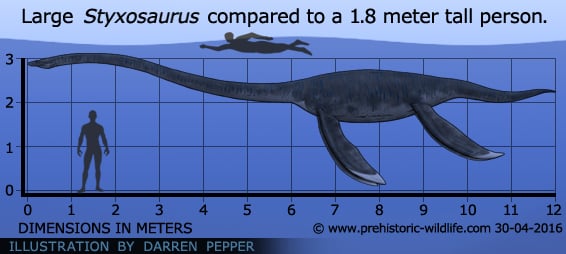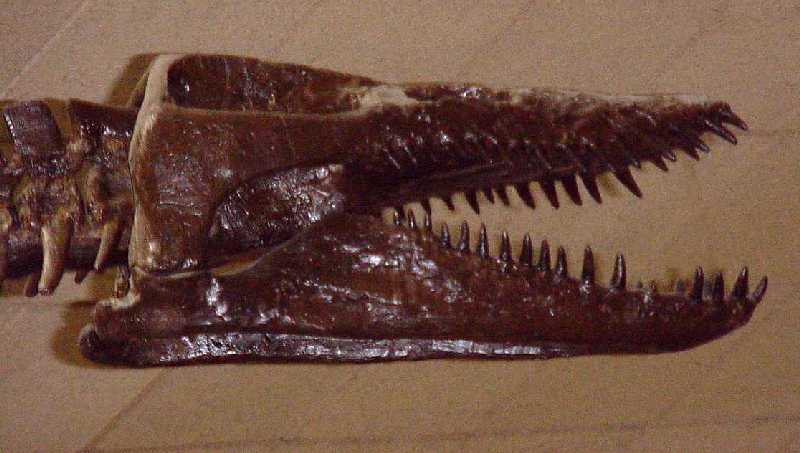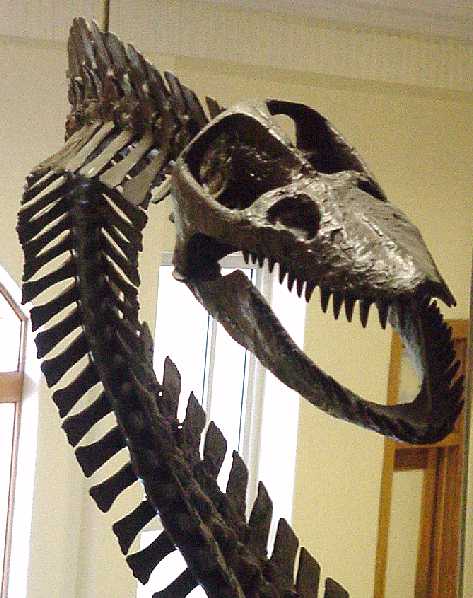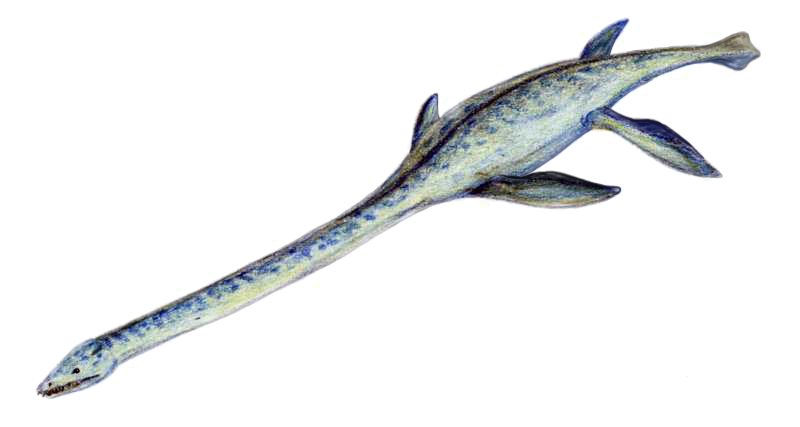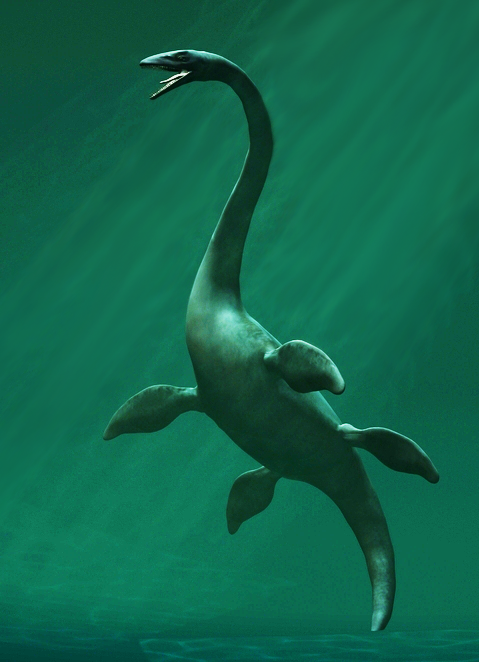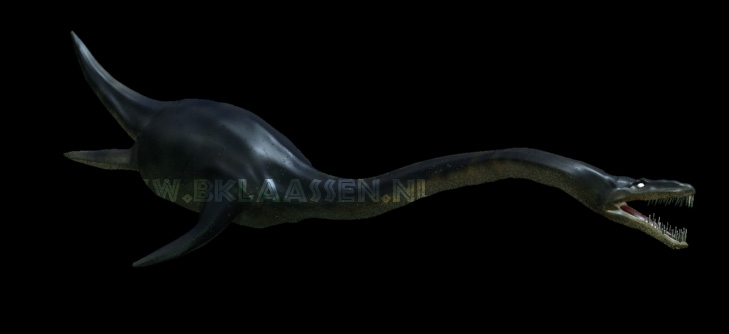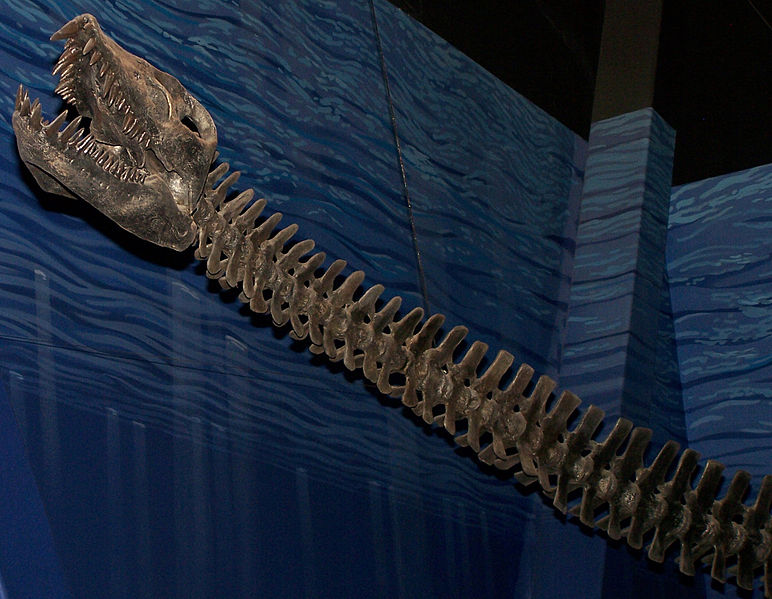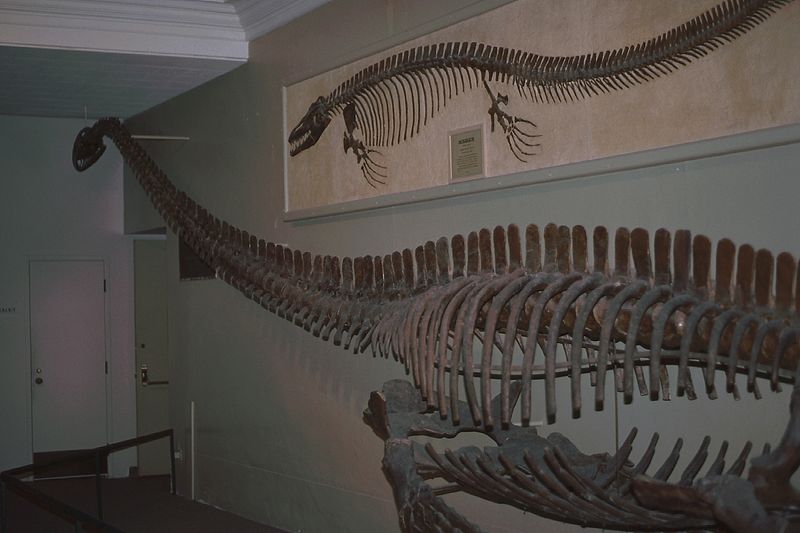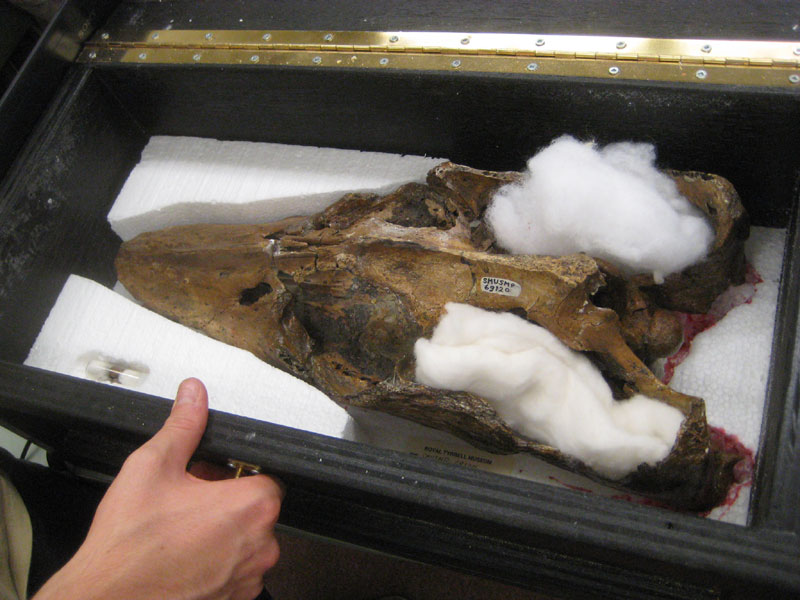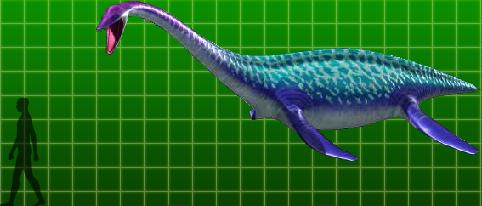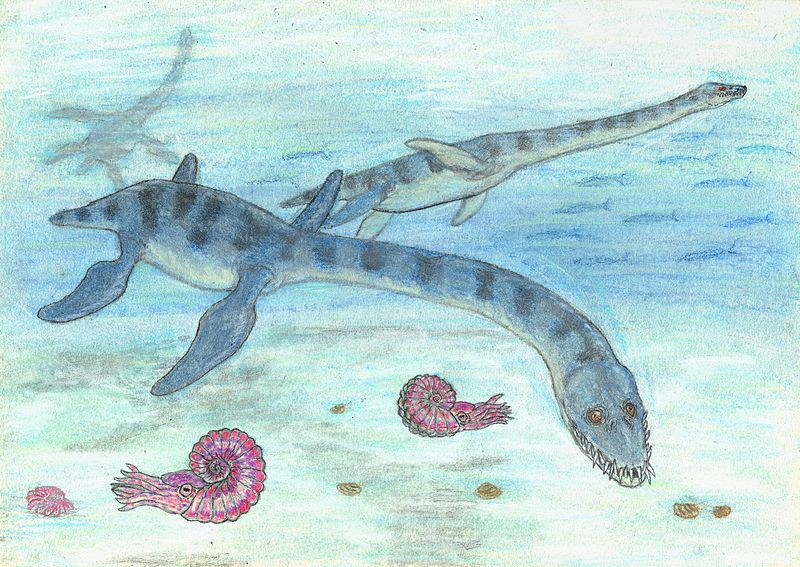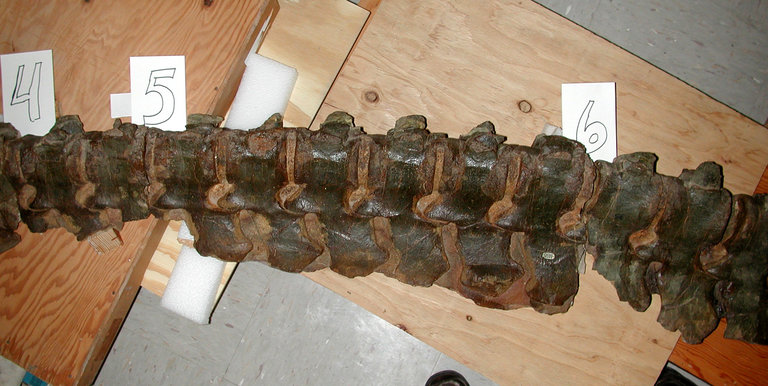[Recent Entries][Archive][Friends][User Info]
Below are the 9 most recent journal entries recorded in the "Сообщество, посвящённое ра" journal:| January 7th, 2014 | |
|---|---|
| 06:58 pm [industrialterro] [Link] |
Zarafasaura Zarafasaura is an extinct genus of elasmosaurid known from the Oulad Abdoun Basin of Morocco. Zarafasaura is known from the holotype OCP-DEK/GE 315, an articulated incomplete dorsoventrally crushed skull and mandible and from the paratype OCP-DEK/GE 456, a complete mandible. The holotype was collected in the Sidi Daoui area, from the Upper CIII level of the upper Cretaceous (latest Maastrichtian stage) Phosphates of Morocco. Zarafasaura was first named by Peggy Vincent, Nathalie Bardet, Xabier Pereda Suberbiola, Baâdi Bouya, Mbarek Amaghzaz and Saïd Meslouh in 2011 and the type species is Zarafasaura oceanis. The generic name is derived from zarafa (زرافة), Arabic for "giraffe" (it refers to the name given by the local population to the plesiosaurs found in the phosphates) and saurus, Greek for "lizard". The specific name is derived from oceanis, Latin for "daughter of the sea". Первый относительно полный скелет мелового плезиозавра обнаружили палеонтологи в марокканской фосфоритной шахте. Теперь ученые смогут лучше представить себе животный мир Африки накануне великого мел-палеогенового вымирания. Плезиозавры – довольно широко распространенная и хорошо изученная группа древних рептилий. Формально они не входят в состав отряда динозавров, но жили и вымерли в одно время с ужасными ящерами. "Околоящеры", как переводится с греческого название плезиозавров, были широко распространены в морях с триасового по конец мелового периода, а самые важные, ключевые их остатки находили в Австралии, Европе и Северной Америке. Представители африканского вида плезиозавров Zarafasaura oceanis жили в самом конце мелового периода, в маастрихтский век, и достигали примерно семи метров в длину. Реконструкции черепа этих животных, крепившегося к длинной "жирафьей" шее, показывают, что многочисленные длинные острые зубы при сведении челюстей смыкались между собой, образуя эффективную ловушку для добычи – рыбы и кальмаров. Своих жертв зарафазавры, вероятно, проглатывали целиком, поскольку их зубы не подходят для разделки добычи на более мелкие фрагменты. Родовое имя этого плезиозавра состоит из женской формы обычного для названий многих рептилий окончания –saurus, то есть ящер, и арабского слова zarafa – жирафа. Видовое восходит к древнегреческой мифологии и обозначает одну из дочерей Океана. Впервые этот вид был описан в 2011 году, но до последнего времени было известно лишь два образца этих животных – изолированный череп и хорошо сохранившаяся нижняя челюсть. И вот, наконец, почти полный скелет зарафазавры был найден в окрестностях марокканского города Уэд-Зем. "Из-за отсутствия посткраниального (то есть расположенного позади черепа) скелета предыдущим исследователям было трудно судить о том, как жил этот ящер", – рассказал соавтор исследования Уильям Вол из Вайомингского центра динозавров. "Открытия полных и сочлененных скелетов плезиозавров в Африке довольно редки, на сегодняшний день известно лишь несколько подобных образцов, – отметил Дин Ломакс, ведущий автор исследования и ассистент куратора палеонтологического подразделения британского музея Донкастера. – Многие образцы из Марокко очень фрагментарны и их идентификация обычно затруднена, если не невозможна". Новая находка, представляющая собой череп и значительную часть скелета, позволит ученым лучше понять, что представляли собой зарафазавры при жизни. "Самое главное, что в новом экземпляре сохранились многочисленные элементы вроде костей конечностей, позвонков, грудных и тазовых костей, благодаря которым теперь изолированные и разрозненные находки смогут быть идентифицированы, в случае их принадлежности к Zarafasaura", – приводит Sci-News.com слова Ломакса. "Мы надеемся, что новый вид плезиозавров оживит интерес к до сих пор не определенным образцам из Марокко, хранящимся во многих коллекциях", – поддержал его Вол. Ископаемые останки (1, 2, 3, 4, 5): Tags: Вымершие рептилии, Мел, диапсиды, завроптеригии, лепидозавроморфы, плезиозавроиды, плезиозавры, эласмозавриды |
| 06:35 pm [industrialterro] [Link] |
Woolungasaurus Woolungasaurus glendowerensis ('Glendower's Woolunga lizard', named after an Aboriginal mythical reptile, Persson 1960) is a plesiosaur, an extinct marine reptile, belonging to the Elasmosauridae. The type species Woolungasaurus glendowerensis, named by Per Ove Persson in 1960, is known from a partial skeleton, holotype QM F6890, (forty-six vertebrae, ribs, forearms, shoulder girdle and part of the rear limbs) unearthed from the Wallumbilla Formation (Albian, Lower Cretaceous) of the Richmond District, Queensland. The specific name refers to Glendower Station. Another find of undetermined species, consisting of twelve vertebrae, was unearthed from the Maree Formation (Cretaceous, of uncertain age) of Neale's River, near Lake Eyre, South Australia. In addition a skull from Yamborra Creek, near Maxwelltown, Queensland, described by Persson in 1982 has been referred to Woolungasaurus. Woolungasaurus appears to have been a typical elasmosaur, with forty sharp teeth and an estimated length of about 9.5 metres. Persson (1982) believes it to be closely related to the North American elasmosaur Hydralmosaurus. The genus was referred to Styxosaurus by Sven Sachs in 2004. Tags: Вымершие рептилии, Мел, диапсиды, завроптеригии, лепидозавроморфы, плезиозавроиды, плезиозавры, эласмозавриды |
| 04:26 pm [industrialterro] [Link] |
Styxosaurus Стиксозавр (Styxosaurus) — род вымерших рептилий из надотряда зауроптеригий, отряда плезиозавров, семейства эласмозаврид, живший с сантонского по кампанский век (так называемая «сенонская субэпоха») мелового периода, то есть примерно 85-70 миллионов лет назад. Этот ящер получил своё название в честь реки Стикс (др.-греч. Στύξ) из древнегреческой мифологии, которая отделяла царство мрачного Аида от живого мира. Часть слова «-завр» происходит от σαῦρος (sauros), что означает «ящерица». Типовой экземпляр был обнаружен в месторождении Хелл-Крик, в Логан Кантри, штат Канзас. Он и послужил материалом для названия, придуманного палеонтологом Сэмюэлем Полом Уэллесом, который описал этот род в 1943 году. В длину стиксозавр достигал 11-12 метров, весил 3-4 тонны, по размерам был сопоставим с автобусом. Как и у других эласмозаврид, у стиксозавра была очень длинная шея, занимавшая чуть ли не половину от общей длины ящера. Более того, стиксозавр являлся одной из самых длинношеих морских рептилий за всю историю Земли. Он также обладал большим, крепким туловищем. По мнению палеонтологов, длинная шея у стиксозавра была главным охотничьим приспособлением, позволяя ему врезаться в косяки рыб с минимальными затратами энергии. Широкое распространение получила теория о том, что такие длинношеие эласмозавриды, как стиксозавр, приближались к стае рыб снизу, пряча своё тело в мутной воде на глубине, так, что рыбы могли видеть только переднюю часть их головы. Такое поведение снижало возможность того, что атака ящера окажется заранее замеченной, и соответственно, увеличивало шанс успешной охоты. Стиксозавр обладал типичными для таких ящеров тонкими, острыми зубами, которые сцеплялись друг с другом, когда он закрывал пасть, что не оставляло жертве никаких шансов вырваться из этого капкана после того, как она оказывалась в зубах плотоядного. Его зубы были идеально приспособлены для того, чтобы хватать и удерживать добычу, но они были совершенно неспособны резать или пережёвывать её, поэтому ящеру приходилось заглатывать её целиком. Описание типового экземпляра вида Styxosaurus snowii было выполнено Сэмюэлем Уэнделлом Уиллистоном по целиком сохранившемуся черепу и двадцати шейным позвонкам. Другой весьма полный образец — SDSMT 451 (длиной около 11 метров) — был обнаружен около Ионы, места, расположенного в штате Южная Дакота, США, в 1945 году. Изначально этот вид был описан и назван как Alzadasaurus pembertoni (в честь города Альзада в штате Монтана, США, в окрестностях которого и были найдены останки этого вида) Уэллесом и Джеймсом Бампом в 1949-м и носил такое название вплоть до того момента, как палеонтолог Кен Карпентер признал его синонимом вышеупомянутого вида Styxosaurus snowii. В грудной полости этого скелета находилось свыше 200 (по некоторым данным, около 250) гастролитов — камней, которые ящер глотал с целью облегчить переваривание пищи. Любопытно, что в Школе Горнорудного дела скелет стиксозавра установлен так, что голова его смотрит вверх, выглядывая из воды, хотя в действительности этому ящеру принять такую позицию было физически невозможно. Несмотря на то, что большинство плотоядных для перемалывания пищи не используют гастролиты, их нашли почти во всех хорошо сохранившихся скелетах эласмозаврид. Представляется вероятным, что ящер использовал эти камни в качестве балласта, то есть для создания противодействия поднимающему эффекту воздуха в лёгких, который позволял бы ему плавать ближе ко дну, где он мог легче найти пищу. Но против этой версии говорят несколько фактов: первое — тот факт, что в одном из скелетов этого ящера, который был найден в сланцах Пьера в западном Канзасе, были обнаружены размолотые кости рыбы, перемешанные с гастролитами, а второе — известно, что вес гастролитов, обнаруженных в останках эласмозаврид, значительно меньше 1 % предполагаемой массы, которую имели эти животные при жизни. Таким образом, если в наши дни крокодилы и некоторые другие животные используют гастролиты в качестве балласта, вполне вероятно, что эласмозавры использовали их, так как их используют современные зерноядные птицы - как вспомогательное средство для перемалывания пищи, своеобразную «мельницу» (см. Хендерсон (2006), обратное утверждает Уингс (2004)). На сегодняшний день известно 4 коллекции останков стиксозавра, которые находятся в Канзасе и Южной Дакоте. Останки стиксозавра находят в формации Niobrara, в звене Upper Smoky Hill, с биостатиграфической точки зрения — в так называемой «Зоне гесперорниса», или Spinaptychus sternbergi. Вид Styxosaurus snowii принадлежит к семейству Elasmosauridae и является близким родственником Elasmosaurus platyurus, останки которого были обнаружены в Канзасе в 1867 году. Первый из описанных стиксозавров был первоначально назван Cimoliasaurus snowii Сэмюэлем Уиллистоном в 1890 году. Этот экземпляр включал целиком сохранившийся череп и более двадцати шейных позвонков (KUVP 1301), которые были найдены около Хелл-Крик Э. П. Вестом, палеонтологическим ассистентом университета Канзаса. Затем вид был переименован в Elasmosaurus snowii Уиллистоном в 1906-м, а впоследствии в Styxosaurus snowii Уэллесом в 1943 году. Другой вид, Styxosaurus browni, получил название в 1952 благодаря Уэллесу. Но, тем не менее, впоследствии он был признан синонимичным к гидралмозавру. Также среди известных синонимов стиксозавра нужно выделить такие виды, как Alzadasaurus kansasensis, Thalassiosaurus ischiadicus (греч. thalassa — «морской», «принадлежащий морю») и Thalassonomosaurus marshi (греч. nomo — «жить», «обитать»). Как и большинство других плезиозавров, стиксозавр, вероятно, питался белемнитами, кальмарами и рыбой (такими её разновидностями, как, к примеру, гилликус). Одной из главных особенностей челюстей стиксозавра было то, что они обладали мёртвой, блокирующей хваткой, что позволяло ящеру удерживать даже столь скользкую добычу. Репродукции (1, 2, 3, 4, 5, 6, 7): ( Read More ) Размеры тела в сравнении с человеком: Ископаемые останки (1, 2, 3, 4, 5): Tags: Вымершие рептилии, Мел, диапсиды, завроптеригии, лепидозавроморфы, плезиозавроиды, плезиозавры, эласмозавриды |
| January 2nd, 2014 | |
| 04:01 pm [industrialterro] [Link] |
Elasmosaurus Эласмозавр (Elasmosaurus — «ящер с тонкими пластинами») — гигантский плезиозавр позднего мелового периода (85—65 млн лет назад). Останки обнаружены на территории Канзаса (США), Росcии и Японии. Достигал в длину 15 метров, впервые был описан Эдвардом Копом в 1868 году. Своё название получил за плоские кости плечевого и тазового пояса. В длинной (до 8 м) шее эласмозавра было 72 позвонка — больше, чем у любого другого известного животного. Нижняя часть плечевого пояса и тазобедренные кости растянуты в широкие, похожие на тарелки, структуры, к которым крепятся мощные мышцы, управляющие ластами. Голова по сравнению с телом крошечная, но она снабжена очень широкой пастью, вооружённой острыми, похожими на шипы, зубами. Судя по содержимому желудка, эласмозавр мог ловить самых быстрых рыб того времени. Как и у других плезиозавроидов, длинная шея эласмозавра служила для того, чтобы он мог хватать проворных рыб, не передвигая слишком быстро своё тучное тело. Время от времени эласмозавры заплывали на мелководья. Здесь они погружались на дно и заглатывали небольшие гладкие камешки, которые способствовали размельчению пищи в желудке и служили в качестве балласта. В желудке одного эласмозавра учёные обнаружили более 250 таких голышей. Изучение этих камней показало, что в течение жизни эласмозавры преодолевали в океане тысячи километров, собирая гальку и голыши в различных частях морского побережья. Видимо, детёныши эласмозавров, как и ихтиозавров, рождались в море. Elasmosaurus (/iːˌlæzmɵˈsɔrəs/; from Greek ελασμος elasmos 'thin plate' (referring to thin plates in its pelvic girdle) + σαυρος sauros 'lizard') is a genus of plesiosaur with an extremely long neck that lived in the Late Cretaceous period (Campanian stage), 80.5 million years ago. Elasmosaurus was about 14 m (46 ft) in length and weighed over 2,000 kg (2.2 short tons), making it among the largest plesiosaurs. It differs from all other plesiosaurs by having six teeth per premaxilla (the bones at the tip of the snout) and 71 neck (cervical) vertebrae. The skull was relatively flat, with a number of long pointed teeth. The lower jaws were joined at the tip to a point between the fourth and fifth teeth. The neck vertebrae immediately following the skull were long and low, and had longitudinal lateral crests. Like most elasmosaurids, Elasmosaurus had around three pectoral vertebrae. The tail included at least 18 vertebrae. The pectoral girdle featured a long bar, not present in juveniles. The scapula had margins of approximately equal length for the joint with the coracoid and the articular surface for the upper arm. The anterior edge of the pelvic girdle was made up of three almost straight edges directed to the front and sides of the animal. The ischia, a pair of bones that formed the posterior part of the pelvis, were joined along their medial surfaces. The limbs of Elasmosaurus, like those of other plesiosaurs, were modified into approximately equally sized rigid paddles. Certain aspects of the anatomy of Elasmosaurus were fairly derived among elasmosaurids, and plesiosaurs in general. As noted, Elasmosaurus can be distinguished by its six premaxillary teeth and 71 cervical vertebrae. Primitively, plesiosaurs and most elasmosaurids had five teeth per premaxilla. Some elasmosaurids had more: Terminonatator had nine and Aristonectes had 10 to 13. In addition, most plesiosaurs had fewer than 60 cervical vertebrae. Aside from Elasmosaurus, plesiosaurs that exceeded 60 cervicals include Styxosaurus, Hydralmosaurus, and Thalassomedon. Elasmosaurus is the only known plesiosaur with more than 70 cervicals. However, it had roughly the same neck length as Thalassomedon because the latter has proportionally longer vertebrae. Elasmosaurus had more vertebrae than any known animal. The presence of the pectoral bar is also considered an advanced feature. The long, low axis centrum differs from the condition seen in most other plesiosaurs, which have centra that are either shorter in length than height, or about equidimensional. Styxosaurus and Hydralmosaurus also have the condition present in Elasmosaurus. Another unusual feature of Elasmosaurus is the relatively equal lengths of the margins of the scapula, as mentioned above. Most plesiosaurs had longer margins for articulation with the coracoid than for articulation with the upper arm. While numerous species of Elasmosaurus have been named since its discovery, a 1999 review by Ken Carpenter showed that only one, the type species Elasmosaurus platyurus, could be considered valid. Various other species assigned to the genus are either dubious or have been classified in other genera. For example, E. serpentinus has been reclassified as Hydralmosaurus, E. morgani as Libonectes, and E. snowii as Styxosaurus. By the early part of the Late Cretaceous, plesiosaurs have evolved (or have been reduced) into two distinct groups. Elasmosaurus is the type genus for one of these groups, the elasmosaurids which had extremely long necks with relatively short heads, in contrast to the polycotylids which had shorter necks and relatively larger heads. Late Cretaceous elasmosaurids from the Western Interior of North America have few features that separate them and are morphologically primitive. However, as noted above, Elasmosaurus and some others have some derived features. It has been suggested that Elasmosaurus was closely related to Hydralmosaurus and Styxosaurus due to these advanced features. Elasmosaurus platyurus was described in March, 1868 by Edward Drinker Cope from a fossil discovered and collected by Dr. Theophilus Turner, a military doctor, in western Kansas, USA. Although other specimens of elasmosaurs have been found in various locations in North America, Carpenter (1999) determined that Elasmosaurus platyurus was the only representative of the genus. When E. D. Cope received the specimen in early March, 1868, he had a pre-conceived idea of what it should look like, and mistakenly placed the head on the wrong end (i.e. the tail). In his defense, at the time he was an expert on lizards, which have a short neck and a long tail, and no one had ever seen a plesiosaur the size of Elasmosaurus. Although popular legend notes that it was Othniel Charles Marsh who pointed out the error, there is no factual justification for this account (see below). However, this event is often cited as one of the causes of their long-lasting and acrimonious rivalry, known as the Bone Wars. In fact, although Marsh personally collected at least one plesiosaur from Kansas, and had several more from Kansas in the Yale Peabody collection, he never published a single paper on them. Although Cope verbally announced the discovery of Elasmosaurus platyurus in March 1868, he did not publish the "preprint" of his erroneous reconstruction of Elasmosaurus until August 1869. While much smaller, long-necked plesiosaurs from the Jurassic of England were well known at the time, this was the first time anyone had ever seen a Cretaceous elasmosaur. Cope's reconstruction showed it to have a long sinuous tail like a lizard or a mosasaur. Note that while O.C. Marsh claimed to have pointed out Cope's error "20 years after the fact" in an 1890 newspaper article, it was actually Joseph Leidy who pointed out the problem in his Remarks on Elasmosaurus platyurus address at the Academy of Natural Sciences of Philadelphia meeting on March 8, 1870. Elasmosaurus fossils have been found in the Campanian-age Upper Cretaceous Pierre Shale of western Kansas. The Pierre Shale represents a period of marine deposition from the Western Interior Seaway, a shallow continental sea that submerged much of central North America during the Cretaceous. Like most plesiosaurs, Elasmosaurus was incapable of raising anything more than its head above the water as it is commonly depicted in art and media. The weight of its long neck placed the center of gravity behind the front flippers. Thus Elasmosaurus could only have raised its head and neck above the water if in shallow water, where it could rest its body on the bottom. The weight of the neck, the limited musculature, and the limited movement between the vertebrae would have prevented Elasmosaurus from raising its head and neck very high as well. Nevertheless one study found that the necks of elasmosaurs were capable of 75–177˚ of ventral movement, 87–155° of dorsal movement, and 94–176° of lateral movement, depending on the amount of tissue between the vertebrae. "Swan-like" S-shape neck postures which required more than 360° of vertical flexion were not possible. The head and shoulders of the Elasmosaurus most likely acted as a rudder. If the animal moved the anterior part of the body in a certain direction, it would cause the rest of the body to move in that direction. Thus, Elasmosaurus could not have swum in one direction while moving its head and neck either horizontally or vertically in a different direction. Elasmosaurus was a slow swimmer and may have stalked schools of fish. The long neck would allow Elasmosaurus to conceal itself below the school of fish. It then would have moved its head slowly and approached its prey from below. The eyes of the animal could have had stereoscopic vision, which would help it find small prey. Hunting from below would also have helped by silhouetting the prey in the sunlight while concealing Elasmosaurus in the dark waters below. Elasmosaurus probably ate small bony fish, belemnites (similar to squid), and ammonites (molluscs). It swallowed small stones to aid its digestion. Elasmosaurus is believed to have lived mostly in open ocean. The paddles of Elasmosaurus and other plesiosaurs are so rigid and specialized for swimming that they could not have come on land to lay eggs. Thus it most likely gave live birth to its young like modern sea snakes. While direct evidence of reproduction in Elasmosaurus is not yet known, the contemporaneous plesiosaur Polycotylus is known to have given birth to live young
Репродукции (1, 2, 3, 4, 5, 6, 7, 8, 9, 10, 11, 12, 13): ( Read More ) Размеры тела в сравнении с человеком: Ископаемые останки (1, 2, 3, 4): Tags: Вымершие рептилии, Мел, диапсиды, завроптеригии, лепидозавроморфы, плезиозавроиды, плезиозавры, эласмозавриды |
| December 31st, 2013 | |
| 05:39 pm [industrialterro] [Link] |
Mauisaurus Mauisaurus ("Maui reptile") is a genus of plesiosaur that lived during the Late Cretaceous period around 80 to 69 million years ago in what is now New Zealand. It was the largest plesiosaur, and perhaps the largest marine reptile in New Zealand waters at the time. Mauisaurus haasti is the only known species of the genus. A handful of specimens have been found, although only a few are well preserved and mostly complete. The only other established New Zealand plesiosaur, Tuarangisaurus keyesi, cannot be linked as a direct relative to Mauisaurus. Mauisaurus was similar to other plesiosaurs. It had a characteristically long neck, that grew up to 15 metres (49 ft) in length, more than half its total length. Mauisaurus' neck length makes it one of the top plesiosaurs with a large neck to body length ratio. In total, Mauisaurus grew to around 20 metres (66 ft) in length and was easily the largest plesiosaur in New Zealand waters. Like other plesiosaurs, it had a long slender body, with numerous vertebrae, allowing flexible movement. On its underside, Mauisaurus had two sets of large flippers. These aided in swimming at high speeds, but may have also allowed the plesiosaur to venture onto shorelines for short amounts of time. Mauisaurus was a carnivore, with sharp jagged teeth that would have been used to grip fish or squid. Mauisaurus remains have all been found in New Zealand's South Island, near Canterbury. Altogether, around seven Mauisaurus specimens have been found in the area, most in or around the Waipara River. One Mauisaurus fossil was even found battling a mosasaur from the New Zealand region. Mauisaurus gardneri was described in 1877, but was later found to be separate to Mauisaurus haasti and is now considered a nomen nudum. Mauisaurus gets its name from the New Zealand Māori mythological demigod, Māui. Māui is said to have pulled New Zealand up from the seabed using a fish hook, thus creating the country. Thus, Mauisaurus means "Māui reptile". Mauisaurus gets its scientific last name from its original finder, Julius Haast, who found the first Mauisaurus fossil in 1870. The specimen was then first described in 1874. Mauisaurus is one of the few New Zealand prehistoric creatures, and so, has had much publicity in the country. On 1 October 1993, a set of stamps was released to the general public. Although it depicted many other dinosaurs and prehistoric life, Mauisaurus was featured hunting fish on the $1.20 stamp. Tags: Вымершие рептилии, Мел, диапсиды, завроптеригии, лепидозавроморфы, плезиозавроиды, плезиозавры, эласмозавриды |
| 05:25 pm [industrialterro] [Link] |
Libonectes Libonectes (meaning "southwest swimmer") is an extinct genus of sauropterygian reptile belonging to the plesiosaur order. It is known from a single fossil specimen found in the Britton Formation of Texas, dated to the lower Turonian stage of the late Cretaceous period. The animal was very similar to the related Thalassomedon, though the structure of the neck vertebrae were different, with taller neural spines and longer supporting processes of the bone, and its nostrils were slightly closer to the tip of the skull. The skull of the type specimen is the best preserved elasmosaurid skull known. The specimen consists of the skull and neck, as well as gastroliths found along with the fossil. A shoulder girdle and flipper were also found but were apparently discarded at some point in the past. The specimen was originally named Elasmosaurus morgani by Welles in 1949, but it was reclassified in its own genus by Carpenter in 1997. Tags: Вымершие рептилии, Мел, диапсиды, завроптеригии, лепидозавроморфы, плезиозавроиды, плезиозавры, эласмозавриды |
| 04:44 pm [industrialterro] [Link] |
Futabasaurus Futabasaurus is a genus of plesiosaur from the Late Cretaceous of Fukushima, Japan. Described and named in 2006, it was assigned to the family Elasmosauridae. The length was about 7 m, and the weight was about 3~4 tons. Long distance between the eye sockets and nostrils. Interclavicles and clavicles are fused and the anterior edge is bent. Relatively long upper arm. Slim thigh bones with a significant muscle scar. Futabasaurus suzukii was named from the family name of discover Suzuki, and futaba from the Futaba Group. The name "Futabasaurus" also appears in connection with a theropod dinosaur, also from the Late Cretaceous of Japan. However, this dinosaur was not officially named, so the dinosaur "Futabasaurus" is a nomen nudum when applied to this theropod. It is not the same as the plesiosaur named Futabasaurus. Futabasaurus is the first elasmosaurid found in Japan. The type species is F. suzukii. Many of the bones of the type specimen show apparent scavenging or predation by sharks. The first fossils of Futabasaurus were found in the Irimazawa Member of the Tamayama Formation, Futaba Group, Fukushima Prefecture, Japan, dating to the Inoceramus amakusensis zone of the early Santonian. The fossils were found by Tadashi Suzuki, a high school student around that time.
Размеры тела в сравнении с человеком: Tags: Вымершие рептилии, Мел, диапсиды, завроптеригии, лепидозавроморфы, плезиозавроиды, плезиозавры, эласмозавриды |
| 03:27 pm [industrialterro] [Link] |
Callawayasaurus Callawayasaurus is a genus of plesiosaur from the family Elasmosauridae. When the first Callawayasaurus fossil was first discovered by Samuel Paul Welles in 1962, he described it as Alzadasaurus colombiensis before it was moved into its current genus by Kenneth Carpenter in 1999. Callawayasaurus (Callaway) is named in honor of the paleontologist, Jack M. Callaway, editor of Ancient Marine Reptiles who, as Carpenter put it, "in his brief career as a vertebrate paleontologist, did much to improve our understanding of marine reptiles". The familiar suffix, -saurus comes from the Greek sauros (σαυρος), meaning "lizard" or "reptile". The first skull of Callawayasaurus to be found was 35 cm long, while the animal as a whole grew up to 8 m long. The nares of Callawayasaurus are elongated and positioned over the maxilla, which has 3-5 teeth. The neck contains 56 vertebrae which are relatively short compared to other elasmosaurids. Callawayasaurus fossils have no pectoral bars; in common with other plesiosaurs such as Terminonatator. They also lack postaxial accessory facets. Another nearly complete skeleton was found to be slightly more robust than the holotype specimen. This subtle change may indicate sexual dimorphism. The fist Callawayasaurus remains were found in the Paja Formation near Leiva, Boyaca Colombia. The species name for the type, "columbiensis", means "from Colombia." Callawayasaurus are known from the Aptian faunal stage of the early Cretaceous period, which extended from 125 to 112 million years ago. Ископаемые останки (1, 2, 3, 4, 5): Tags: Вымершие рептилии, Мел, диапсиды, завроптеригии, лепидозавроморфы, плезиозавроиды, плезиозавры, эласмозавриды |
| December 29th, 2013 | |
| 05:53 pm [industrialterro] [Link] |
Thalassomedon Талассомедон (Thalassomedon, от др.-греч. θᾰλασσομέδων «властелин моря») — род вымерших рептилий из надотряда зауроптеригий, отряда плезиозавров. Вероятнее всего, при своих размерах талассомедон был главным хищником своего времени. А вымер, возможно, в связи с появлением новых грозных плотоядных морских рептилий, таких, как тилозавр. Первое из известных открытий талассомедона датируется 1939 годом, когда палеонтолог Р. Л. Ланденберг обнаружил его голотип в США, в штате Колорадо. А свое название талассомедон получил в 1943 году, благодаря палеонтологу Сэмюэлу Полу Уэллесу. Талассомедон обитал на нашей планете в эпоху сеноманского яруса позднего мелового периода, в море, которое в ту эпоху разделяло на две части Северную Америку, примерно 95 миллионов лет назад. Помимо Колорадо, останки находят также в Монтане. Ближайшим родственником талассомедона был более известный эласмозавр, появившийся несколько позднее. Скелеты талассомедонов выставлены в шести американских палеонтологических музеях, в частности, в Американском музее Естественной истории в Нью-Йорке (голотип AMNH) и в Денверском музее Естественной истории (голотип DMNH). Известно, что черепа у скелетов, выставленных в трех из всех этих музеях — реконструкции, выполненные на основе разрушившихся окаменелостей. Талассомедон относится к эласмозавридам. Типовой вид — Thalassomedon haningtoni (часто встречаются ошибочные написания haringtoni, hanningtoni). В 1943-м Уэллес также описал род Alzadasaurus riggsi. В 1999 году палеонтолог Карпентер признал его синонимичным к Thalassomedon haningtoni. Другой род альзадазавра, A. colombiensis, был переименован в Callowayasaurus, остальные виды были признаны синонимичными по отношению к стиксозавру. При своей общей длине в 12 метров, талласомедон по меркам своего семейства был плезиозавром средних размеров, особенно в сравнении с гигантскими родственниками мауизаврами. При таких габаритах только его ласты были длиной от полутора до двух метров. В шее насчитывалось 62 позвонка. Длина черепа составляла 47 сантиметров, в то время как зубы составляли в длину 5 сантиметров. Весьма интересно, что при раскопках в желудках талассомедонов находят окаменевшие камни. Но если стиксозаврв использовали их для улучшения переваривания пищи (рыбы, которой они питались), то талассомедоны, вероятнее всего, использовали их только как балласт. Elasmosauridae was a family of plesiosaurs. They had the longest necks of the plesiosaurs and survived from the Late Triassic to the end of the Cretaceous. They had a diet of fish and shelless cephalopods. The earliest elasmosaurids were small, about 3 m (9.8 ft). At the end of the Cretaceous, elasmosaurids grew as large as 14 m (46 ft), such as Elasmosaurus. Their necks were the longest of all the plesiosaurs, with anywhere between 32 to 76 (Albertonectes) cervical vertebrae They weighed up to several tons. The family Elasmosauridae was erected by Cope in 1869, and anchored on the genus Elasmosaurus. Размеры тела в сравнении с человеком: Tags: Вымершие рептилии, Мел, диапсиды, завроптеригии, лепидозавроморфы, плезиозавроиды, плезиозавры, эласмозавриды |


